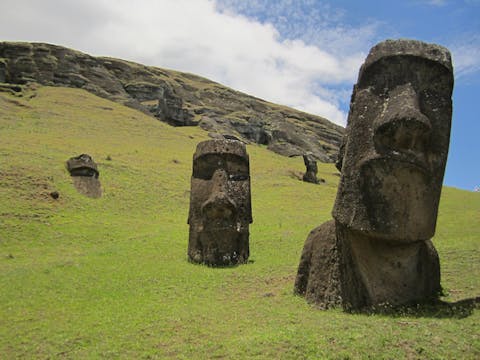Learn About Oceanic Art
Oceanic or Oceanian art is a term that refers to the artwork created by native populations of the Pacific Islands and Australia, including the regions of Micronesia, Melanesia, and Polynesia.
Moai on Easter Island
The indigenous people of these areas established their populations during the first wave of human migrations, and thus their artwork is representative of a mysterious early period in the history of mankind that we often do not have the privilege of knowing very much about. Their artwork provides us a rare insight into prehistoric cultures that we would otherwise have very little evidence of. It is no wonder that today appreciators of art and anthropology alike are more willing to recognize the value of Oceanic art as not only culturally significant symbolizers of the human need to create, but as aesthetically accomplished works of art in itself.
Early migrations
The first people to populate the regions consisting of Oceania came from Southeast Asia at two different times. First, an Australo-Melanisian people arrived in New Guinea and Australia some time between 40,000 and 60,000 years ago. They would become the ancestors of Australian Aboriginals, and Melanisians, who would then expand as far as the Solomon Islands as early as 38,000 years ago. The second group of people to migrate to these regions was a group of Southeast Asian peoples known as the Austronesians, who appeared 30,000 years later and populated even the most remote Pacific islands. At around 1500 BCE, members of the Austronesian culture of Lapita would further expand across even more islands.
Artistic origins
It was during this period of about 1500 BCE that artwork, including early examples of sculpture, would appear in New Guinea. By the time the first century AD came around, trade between the cultures of Oceania and mainland Asia had been growing for quite some time, and we can see evidence of contact with the Dongson culture of Vietnam which would ultimately have great influence over the artwork and visual culture of the Oceanic peoples.

Materials and techniques
Until the 16th century in which Europeans first appeared in these regions, Oceanic cultures various forms of Neolithic technologies, including the usage of the stone blade which was hafted as an adz or axe, sometimes using the Tridacna shell for material when stone resources were scarce. Obsidian, bamboo, and bivalve shells were also chipped into blades for weapons or tools. Animal bone was worked into the shape of needles, awls, and gouges, all tools that assisted in woodworking, which for the most part was the main form of craftsmanship throughout Oceania. Additionally, clay was used to create sculpture as well as instruments and pottery. All of these various resources and the manner in which they were manipulated and employed served to influence the artwork of the region. Oceanic art was largely thought of not in terms of the West’s concept of art for the sake of aesthetics, but as functional tools and artifacts meant for ceremonial or ritualistic purposes.
"Paro, the tallest of the Moai measures at almost 10 metres and weighing 82 tonnes."
Notable Oceanic art
One of the most internationally recognizable works of art is the Moai of Easter Island in Polynesia. These monolithic carvings of human figures by the Rapa Nui people are thought to have been created between 1250 and 1500 in order to personify deified ancestral figures. Paro, the tallest of the Moai measures at almost 10 metres and weighing 82 tonnes. At one time, over 900 of these statues existed and still loomed over their respective clan lands in 1722 when Europeans arrived, however unfortunately by the early 19th century, many had fallen as a result of foreign contact or tribal wars. However today they remain to be revered not only as monumental artistic accomplishments, but incredible physical and technological feats due to their sheer size and weight.
An Ancient Legacy
With such a fascinating and mysterious history, it is no wonder that so many people today are captivated by what Oceanic art has to offer. Its association with cultures directly rooted in the earliest of human civilizations establishes this work as amongst the most culturally and anthropologically significant in the world. With a rising interest in non-Western art on the market it is likely that Oceanic art will continue to gain momentum with collectors and enthusiasts alike.

